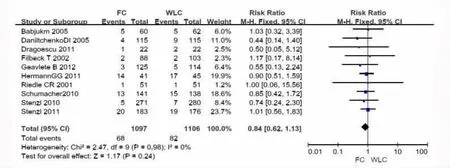荧光膀胱镜引导TUR-bt术疗效的荟萃分析
王伟 刘光明 马洪顺 郝晓明 徐磊
(天津医科大学一中心临床学院/天津市第一中心医院 泌尿外科 天津 300192)
普通膀胱镜引导TUR-bt 是治疗非肌层浸润性膀胱癌的标准方法,但术后肿瘤复发率仍然较高。有报道指出,膀胱癌术后3 个月复发率接近30%,术后1年复发率接近50%[1]。另有报道指出,膀胱癌术后复发与肿瘤残存有关[2]。自荧光膀胱镜引入NMIBC 治疗后,肿瘤术后残存率逐渐降低[3],但其远期疗效至今仍存在争议。为此,本文荟萃分析国内外15 a 内相关研究,旨在探讨荧光膀胱镜辅助下TUR-bt 术较普通膀胱镜在疗效上是否存在优势。
1 材料和方法
1.1 检索方法 英文以fluorescence,white light,bladder cancer/tumour,transurethral resection,recurrence 为关键词,中文以荧光膀胱镜、膀胱癌/膀胱肿瘤、经尿道电切、复发为关键词,检索PubMed、Embase、The Cochrane Library、万方、中国知网数据库2000年1月至2014年12月的随机对照研究,并对相关文献的参考文献进行二次检索,以防遗漏。
1.2 纳入及排除标准 纳入的研究必须同时满足以下标准:①随机对照前瞻性试验;②病例必须有明确的非肌层浸润性膀胱癌诊断证据(病理诊断);③患者TUR-bt 术后必须根据非肌层浸润性膀胱癌危险度进行膀胱灌注治疗;④术后每次随访间隔不得超过3 个月,随访时间至少1 a;⑤至少包含以下1 个目的数据:术后12、24 个月肿瘤复发率及进展率相关数据。满足以下任何1 条的文献均被排除:①非随机对照试验;②独立群组试验;③回顾性试验;④单纯分析Cis、Ta、T1 其中某1 项的研究。
1.3 资料提取和质量评估 由两位研究者独立进行资料的提取和质量评价;若遇到分歧,则返回原文查找证据或发邮件咨询原作者或咨询第三方,直到达成一致意见。提取的资料包括研究特征(包括纳入患者的数量、随访时间及发表的杂志等)、患者基本资料(包括年龄、性别、荧光剂的种类等)。入选文献采用Jadad 评分方法[4]进行质量评价,随机化给0~2 分、盲法给0~2 分、撤出和退出给0~1 分,总分≥3 分的文献研究质量较高。
1.4 统计分析 采用ReMan 5.2 软件进行荟萃分析。通过χ2检验评价不同研究间的异质性,显著性水平设定为α=0.1;采用I2对异质性进行定量分析,当I2>50%时,认为纳入的不同研究间存在较大的异质性。根据资料的类型和评价目的选择效应量和统计方法。无异质性或异质性较小的数据采用固定效应模型;有异质性且较大者采用随机效应模型,荟萃分析结果采用森林图表示。
2 结果
2.1 文献纳入情况及文献质量评价 共检出相关文献196 篇,阅读文题、摘要后,有128 篇文献被剔除(综述4 篇、与研究标准不符99 篇、动物实验13篇、个案报道12 篇),剩余68 篇经阅读全文再次排除不符合纳入标准的文献53 篇(观察性研究50篇、无法提取数据3 篇),最终纳入15 个RCT 研究。总病例2 718例。入选研究的一般资料及临床特征见表1。纳入的研究均为临床RCT 研究,所有文献随机化方法均正确,所有研究的Jadad 评分均≥3 分,研究质量均较高。

表1 纳入研究的基本资料
2.2 荟萃分析结果
2.2.1 术后1年、2年复发率影响 对13 组研究的2 865例膀胱癌患者进行荟萃分析显示,荧光膀胱镜引导TUR-bt 术后与普通膀胱镜引导TUR-bt 术后1年复发率差异有统计学意义(RR = 0.71,95% CI 0.58~0.87),荧光组复发率低于普通组。各项研究之间的异质性中等(I2=64%)。为提高结果可信度,在此采用随机效应模型。见图1。
对5 组研究的1 024例膀胱癌患者进行荟萃分析显示:术后2年其复发率差异有统计学意义(RR =0.59,95% CI 0.43~0.81),荧光组2年复发率低于普通光组。但此指标各研究之间表现出中等强度异质性(I2=59%)。为提高结果可信度,在此亦采用随机效应模型。见图2。
2.2.2 术后远期肿瘤进展率 对10 组研究的2 205例膀胱癌患者术后肿瘤进展率进行荟萃分析显示,荧光组与普通光组术后复发率差异无统计学意义(RR =0.84,95%CI 0.62~1.13)。各研究之间无明显异质性(I2=0%),在此采用固定效应模型。见图3。

图1 荧光膀胱镜与普通膀胱镜治疗NMIBC 术后1年复发率比较

图2 荧光膀胱镜与普通膀胱镜治疗NMIBC 术后2年复发率比较

图3 荧光膀胱镜与普通膀胱镜治疗NMIBC 术后远期进展率比较
3 讨论
荧光膀胱镜引入膀胱癌的诊断和治疗后,其带来的直接益处是:①更多肿瘤被探测到;②提高了肿瘤的发现率;③减少了肿瘤的残存[19]。但是,荧光膀胱镜辅助TUR-bt 的治疗效果一直存在争论。Shen 等[20]曾荟萃分析14 组随机对照研究显示,荧光膀胱镜辅助下TUR-bt 可以降低肿瘤残存率,但在肿瘤1年、2年复发率方面并不存在优势。仔细阅读其文章后发现,其原始文献纳入过程存在缺陷:虽然此文章纳入了14组随机对照研究,但其中一组研究是回顾性研究,且有3 篇文献存在数据重叠。对其结果应慎重解释。
近几年,相关RCT 研究逐渐增多,且其结论大多提示荧光膀胱镜辅助下TUR-bt 复发率较普通膀胱镜有优越性。为此,本研究重新搜集相关数据,严格执行纳入排除标准,对现有原始数据进行荟萃分析。意外的是,所得结论与Shen 等[20]所得结论并不一致。
本文所纳入文献均为前瞻性随机对照研究,且Jadad 评分均≥3 分,文献质量均较高。观察图1、图2可发现,荧光组肿瘤1年复发率总风险比为0.71(95% CI 0.58~0.87)、2年复发率总风险比为0.60(95% CI 0.50~0.73),均小于1,且95% CI 均在中线左侧,提示荧光膀胱镜引导下TUR-bt 在肿瘤1年、2年复发率上存在优势。但观察图3发现,尽管荧光组与普通光组总风险比为0.84,可是总效应区间与中线重叠,不能得出有统计学意义的结论。因此,荧光膀胱镜引导TUR-bt 在远期肿瘤复发率上并无优势。
另外,本研究在文献搜集过程中发现,虽然与本文研究目的符合的相关研究较多,但质量参差不齐,部分研究的细节数据不完整,亦不能通过联系相关作者获取。尽管本文纳入了13 个研究中心的14 个RCT 研究,但许多适合亚组分析的细节资料缺失,难以实施进一步的亚组分析:比如原发肿瘤与复发肿瘤复发率的比较、单发肿瘤与多发肿瘤复发率的比较、不同危险度肿瘤间复发率的比较等。
总之,现有资料分析表明,对比普通膀胱镜,荧光膀胱镜辅助TUR-bt 可降低肿瘤1年、2年复发率,但不能改善肿瘤进展率。如资料条件充足,施行更进一步的亚组分析,其结果可能对临床实践更有指导意义。
[1] O’Brien T,Ray E,Chatterton K,et al.Prospective randomized trial of hexylaminolevulinate photodynamic-assisted transurethral resection of bladder tumour (TURBT)plus single-shot intravesical mitomycin C vs conventional white-light TURBT plus mitomycin C in newly presenting non-muscle-invasive bladder cancer[J].BJU Int,2013,112(8):1096-1104.
[2] Divrik R T,Sahin A F,Yildirim U,et al.Impact of routine second transurethral resection on the long- term outcome of patients with newly diagnosed pT1 urothelial carcinoma with respect to recurrence,progression rate,and disease- specific survival:a prospective randomised clinical trial[J].Eur Urol,2010,58(2):185-190.
[3] Rink M,Babjuk M,Catto J W,et al.Hexyl aminolevulinate-guided fluorescence cystoscopy in the diagnosis and follow- up of patients with non- muscle- invasive bladder cancer:a critical review of the current literature[J].Eur Urol,2013,64(4):624-638.
[4] Jadad A R,Moore R A,Carroll D,et al.Accessing the quality of reports of randomized clinical trails:is blinding necessory[J].Control Clin Trials,1996,17(1):1-12.
[5] Riedl C R,Daniltchenko D,Koenig F,et al.Fluorescence endoscopy with 5-aminolevulinic acid reduces early recurrence rate in superficial bladder cancer[J].J Urol,2001,165(4):1121-1123.
[6] Filbeck T,Pichlmeier U,Knuechel R,et al.Reducing the risk of superficial bladder cancer recurrence with 5-aminolevulinic acid-induced fluorescence diagnosis.Results of a 5-year study[J].Urologe A,2003,42(10):1366-1373.
[7] Babjuk M,Soukup V,Petrik R,et al.5- aminolaevulinic acid- induced fluorescence cystoscopy during transurethral resection reduces the risk of recurrence in stage Ta/T1 bladder cancer[J].BJU Int,2005,96(6):798-802.
[8] Daniltchenko D I,Riedl C R,Sachs M D,et al.Long-term benefit of 5-aminolevulinic acid fluorescence assisted transurethral resection of superficial bladder cancer:5-year results of a prospective randomized study[J].J Urol,2005,174(6):2129-2133.
[9] Denzinger S,Burger M,Walter B,et al.Clinically relevant reduction in risk of recurrence of superficial bladder cancer using 5-aminolevulinic acid-induced fluorescence diagnosis:8-year results of prospective randomized study[J].Urology,2007,69(4):675-679.
[10] Burger M,Stief C G,Zaak D,et al.Hexaminolevulinate is equal to 5-aminolevulinic acid concerning residual tumor and recurrence rate following photodynamic diagnostic assisted transurethral resection of bladder tumors[J].Urology,2009,74(6):1282-1286.
[11] Schumacher M C,Holmang S,Davidsson T,et al.Transurethral resection of non muscle invasive bladder transitional cell cancers with or without 5-aminolevulinic acid under visible and fluorescent light:results of a prospective,randomised,multicentre study[J].Eur Urol,2010,57(2):293-299.
[12] Stenzl A,Burger M,Fradet Y,et al.Hexaminolevulinate guided fluorescence cystoscopy reduces recurrence in patients with nonmuscle invasive bladder cancer[J].J Urol,2010,184(5):1907-1913.
[13] Stenzl A,Penkoff H,Dajc-Sommerer E,et al.Detection and clinical outcome of urinary bladder cancer with 5- aminolevulinic acid- induced fluorescence cystoscopy:A multicenter randomized,double-blind,placebo- controlled trial[J].Cancer,2011,117 (5):938-947.
[14] Dragoescu O,Tomescu P,Panus A,et al.Photodynamic diagnosis of nonmuscle invasive bladder cancer using hexaminolevulinic acid[J].Rom J Morphol Embryol,2011,52(1):123-127.
[15] Hermann G G,Mogensen K,Carlsson S,et al.Fluorescence-guided transurethral resection of bladder tumours reduces bladder tumour recurrence due to less residual tumour tissue in Ta/T1 patients:a randomized two-centre study[J].BJU Int,2011,108(8):297-303.
[16] Karaolides T,Skolarikos A,Bourdoumis A,et al.Hexaminolevulinateinduced fluorescence versus white light during transurethral resection of noninvasive bladder tumor:does it reduce recurrences?[J].Urology,2012,80(2):354-359.
[17] Geavlete B,Multescu R,Georgescu D,et al.Treatment changes and long-term recurrence rates after hexaminolevulinate (HAL)fluorescence cystoscopy:does it really make a difference in patients with non-muscle- invasive bladder cancer (NMIBC)?[J].BJU Int,2012,109(4):549-556.
[18] Gkritsios P,Hatzimouratidis K,Kazantzidis S,et al.Hexaminolevulinate-guided transurethral resection of non-muscle-invasive bladder cancer does not reduce the recurrence rates after a 2-year follow-up:a prospective randomized trial[J].Int Urol Nephrol,2014,46(5):927-933.
[19] Kausch I,Sommerauer M,Montorsi F,et al.Photodynamic diagnosis in non- muscle- invasive bladder cancer:a systematic review and cumulative analysis of prospective studies[J].Eur Urol,2010,57(4):595-606.
[20] Shen P,Yang J,Wei W,et al.Effects of fluorescent light- guided transurethral resection on non- muscle- invasive bladder cancer:a systematic review and meta-analysis[J].BJU Int,2012,110(6):209-215.

